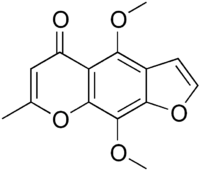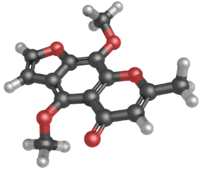Khellin
 | |
 | |
| Names | |
|---|---|
| IUPAC name
4,9-Dimethoxy-7-methylfuro[3,2-g]chromen-5-one | |
| Other names
Amicardine; Corafurone; Methafrone; Kelourin; Rykellin; Visammin ; Ammispasmin; Ammivisnagen; Gynokhellan; Interkellin; Interkhellin; Amikellin; Ammipuran; Benecardin; Deltoside; Kelicorin; Khelangin; Khellamine; Khellanals; Khellinorm; Medekellin; Visammimix; Viscardan; Visnagalin; Kalangin; Kelincor | |
| Identifiers | |
| 82-02-0 | |
| ChEMBL | ChEMBL44746 |
| ChemSpider | 3696 |
| EC number | 201-392-8 |
| |
| Jmol-3D images | Image |
| KEGG | C09010 |
| MeSH | C438920 |
| PubChem | 3828 |
| |
| UNII | 5G117T0TJZ |
| Properties | |
| Molecular formula |
C14H12O5 |
| Molar mass | 260.24 g·mol−1 |
| Except where noted otherwise, data is given for materials in their standard state (at 25 °C (77 °F), 100 kPa) | |
| | |
| Infobox references | |
Khellin is a furanochromone, an organic compound which is derivative of chromone (1,4-benzopyrone) and furan. It has lipophilic properties and causes vasodilation (widening of blood vessels). It is found in the plant Ammi visnaga which has been used in Egyptian folk medicine.
In Egypt, the plant "Khella" was used for renal colic. The incidence of renal colic was due mostly to schistosomiasis infections and stone formation. The plant mixture had diuretic properties that were seen to relieve renal colic in Egyptian folk medicine. After the chemical compound khellin was identified, people began to study its properties. It was found to relax the ureter and coronary arteries.
It is not used as a systemic medication because it is difficult to absorb and causes a range of undesirable side effects such as dizziness, headache, gastrointestinal disorders and nausea. However, it has been used successfully to treat vitiligo by topical application. In the early 20th century, researchers searched for khellin analogs with lower toxicity and better efficacy. A number of drugs were discovered through this research and amiodarone and cromolyn sodium are khellin analogs used in current medical practice.
See also
- Ammi (plant)
- Amikhelline, an antimitotic drug
References
External links
| ||||||||||